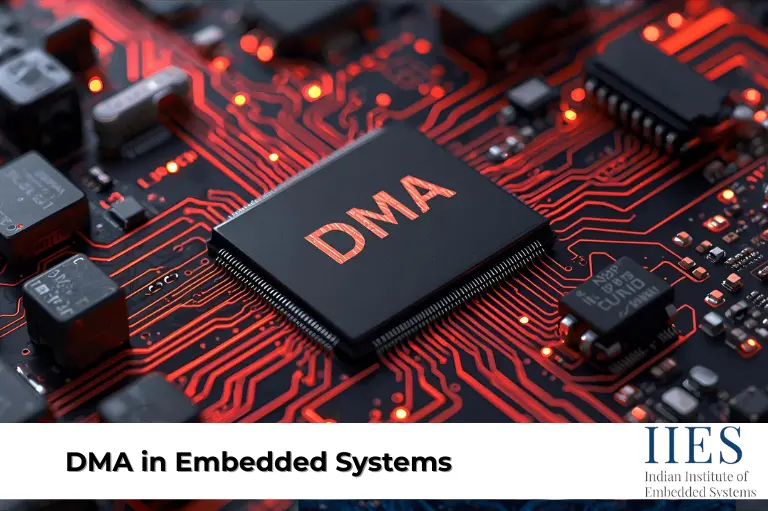
Embedded systems power everything from smartphones to IoT devices, and efficient data handling is vital for their performance. DMA in Embedded Systems (Direct Memory Access) is a key technique that streamlines data transfer, reducing CPU load and enabling faster, real-time processing.
Direct Memory Access (DMA) lets peripherals transfer data directly to memory without constant CPU involvement. This boosts speed, saves resources, and ensures real-time performance in embedded systems.
DMA, or Direct Memory Access, is a feature that allows peripherals to exchange data with system memory directly—without burdening the CPU. In embedded systems, this is especially important because efficiency and speed are often critical.
Normally, the CPU must oversee every byte of data transfer between memory and devices. With DMA, a dedicated DMA controller handles this job. As a result, the CPU can focus on more complex tasks instead of wasting cycles on repetitive data movement.
Efficient data transfer is essential for modern electronics. As devices grow more complex, traditional CPU-driven data movement becomes slow and resource-heavy. Direct memory access control solves this problem with automation and parallelism.
DMA relies on a DMA Controller (DMAC), which manages the transfer process between memory and peripherals. This reduces CPU involvement and ensures smooth data handling.
DMA provides several important advantages that directly impact system performance and usability.
CPU offloading enables faster execution of primary tasks while transfers run independently.
The processor no longer wastes time on repetitive copy operations, freeing it for multitasking.
In time-critical applications like IoT sensors or audio streaming, DMA ensures predictable, timely dma data transfer.
Parallel transfers allow peripherals and the CPU to work efficiently without bottlenecks.
Even though DMA is powerful, it’s not without issues. Designers must handle certain challenges to ensure smooth functioning.
Cache and dma memory synchronization must be managed carefully to avoid corrupted data.
Not all devices work seamlessly with DMA, so proper configuration is essential.
When both the CPU and DMAC need access to the bus, arbitration logic must prevent delays.
As embedded systems evolve, DMA capabilities have also advanced to meet higher performance demands.
High-performance devices use multiple DMA units, each with multiple channels for parallel transfers.
Instead of transferring only continuous blocks, this allows fragmented data to be handled efficiently.
DMA can now move data between memory regions, useful in compression, encryption, or large-scale data copying.
The DMAC adjusts bus width based on the data size, ensuring bandwidth is used efficiently.
DMA is widely used in networking, graphics, audio, and automotive systems. Its ability to manage high-speed dma in microprocessor operations makes it crucial in real-time applications.
Routers, IoT hubs, and servers use DMA to move packets quickly between network interfaces and system memory, ensuring high throughput.
DMA accelerates frame rendering by rapidly transferring textures and frame data between memory and GPUs, improving visual performance.
Real-time audio applications rely on DMA for streaming data from sensors and microphones to memory with minimal CPU usage.
Robotics, automotive ECUs, and factory machines depend on DMA for real-time sensor feedback and motor control.
Fun fact: Early PCs used the 8237 DMA controller, which laid the foundation for today’s advanced DMA engines.
Direct Memory Access (DMA) is a game-changing feature in embedded systems, enabling faster, more efficient data handling. By reducing CPU overhead, it boosts performance, ensures real-time response, and supports advanced applications in IoT, networking, and industrial systems.
DMA in embedded systems allows peripherals to transfer data directly to memory, reducing CPU load and enabling efficient real-time operations.
DMA offloads repetitive data movement from the CPU, enabling multitasking and improving system speed.
DMA channels, request lines, address/data registers, and arbitration logic form the core of a DMA controller.
Peripherals request DMA transfers, which occur in the background, ensuring smooth and predictable real-time data handling.
Benefits include higher speed, low CPU load, and real-time response. Challenges include bus contention, device compatibility, and data coherency.
Yes, DMA is critical for IoT and advanced embedded devices that require efficient, low-latency, high-volume data transfer.
Indian Institute of Embedded Systems – IIES